PSYC 308 Final
1/159
There's no tags or description
Looks like no tags are added yet.
Name | Mastery | Learn | Test | Matching | Spaced |
|---|
No study sessions yet.
160 Terms
Population of indigenous people in Canadian prisons?
25% of total population - 3% of Canadian population
How likely are black people to get a prison sentence in America?
30% more likely to get sentenced than white people for committing the same crime
Those who ”look more black” 2x more likely to get the death penalty
Success of tall men?
Get higher status jobs, paid more than short men
14.5% of US men are above 6 feet, 58% of Fortune 500 CEOs are above 6 feet
Equality in the workplace?
Women paid 80-90% of men’s salary for the same job
are biases towards various human traits going down? (Charlesworth and Banaji, 2022)
Yes - explicit biases are decreasing more than implicit both both are going down in the categories of sexuality, race, skin tone, age, disability, body weight
age had the least change (22%) and race had to most change (98%)
trends in attitudes are mostly the same for liberals and conservatives
prejudice (affect)
negative affect or affective response toward a certain group and its individual members
discrimination (behaviour)
negative behaviour or actions towards members of a particular group based on their membership in that group
unfair treatment because of group membership
can discriminate without prejudice
stereotypes (cognition)
beliefs about attributes that are thought to be characteristic of members of particular groups
thinking about a person not as an individual but as a member of a certain group
contemporary prejudice
some people experience conflict between what they truly think and feel and what they think they should think and feel; conflict between competing beliefs and values; conflict between abstract beliefs and gut reactions
shift in theoretical approaches noteworthy with race relations in US
theory of modern racism (Gaertner and Dovidio; 2986, 2004)
modern racism
white people may reject explicitly racist beliefs, but still feel animosity towards black people or are highly suspicious of them
harbour unacknowledged negative feelings and attitudes toward other racial and ethnic groups that stem from ingroup favouritism and desire to defend the status quo
will emerge if they sense a suitable rationalization is available for it
parochial altruism
endemic intergroup warfare in ancestral environments shows evolutionary evidence of in-group preference - small, cohesive, cooperative but mutally hostile bands
innate tendency for altruism towards ingroup and hostility towards outgroup - us vs. then thinking
flexible and socially constructed - why content of prejudice can be different across content but us vs. them mentality remains
evolutionary psychology explanation for prejudice
pathogen avoidance
strangers were potential sources of novel pathogens for which immune defence is unprepared
behavioural immune system
avoidance of people who are perceived as outgroup members
areas with high pathogen prevalence are more ingroupish, more fear of pathogens leads to more prejudice and stronger immune reaction
evolutionary psychology explanation for prejudice
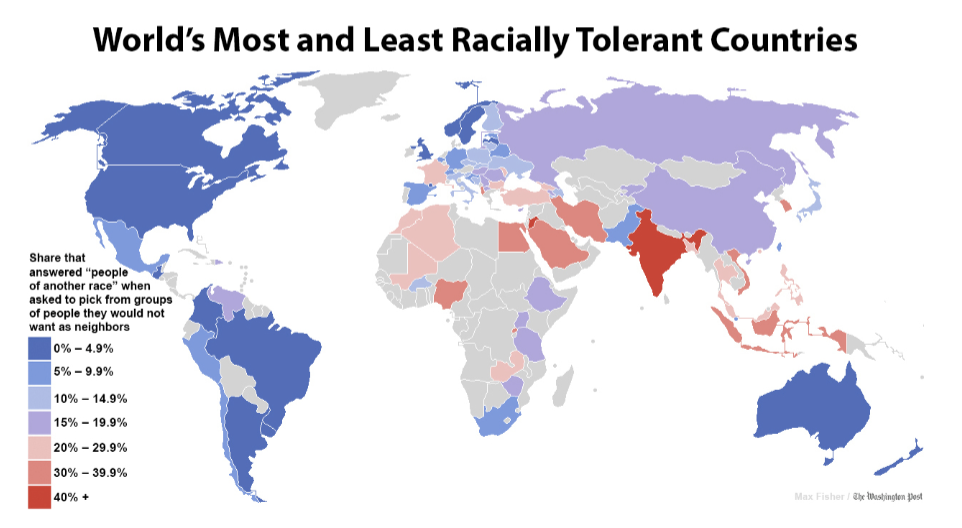
behavioural immune system (Schaller, 2011)
psychological processes that infer infection risk from perceptual cues, and that respond to these perceptual cues through activation of aversive emotions, cognitions and behavioural impulses
cultural explanations for ingroup-outgroup favouritism
cultural dissimilarity = dislike
conversely, similarity, familiarity = liking
Brewer and Campbell (1976): study with 30 African societies - people felt most positive towards groups that were geographically
multiculturalism vs. colour-blindness
difference is okay vs. treat everyone the same
belief in value of multiculturalism is associated with less ethnocentrism (Ryan et al., 2007)
adoption of multicultural outlook improves intergroup relations, improves experiences of disadvantaged groups (Vorauer, Gagnon, Sasaki, 2009)
distal explanations of prejudice
evolutionary and cultural explanations of ingroup behaviour
proximal explanations of prejudice
socioeconomic, motivational, cognitive perspectives
realistic group conflict theory
group conflict, prejudice, discrimination are likely to arise over competition between groups for limited desired resources
socioeconomic explanation for prejudice
high employment and economic recession = more anti-immigrant attitudes
groups who perceive themselves as at risk from other group’s advance are more prejudices (resenting immigrants for taking jobs)
The Robber’s Cave Experiment (Sherif et al., 1961)
proximal
ethnocentrism
the other group is vilified and one’s own group is glorified - realistic groups conflict theory
The Robber’s Cave Experiment (Sherif et al., 1961)
divided boys at a summer camp into 2 groups - they first spent time with only their groups and built norms and hierarchies, then they were brought together and the boys naturally became competitive towards the other group and more cohesive within their group
also found that subordinate goals brought both groups together - goals that both groups cared about and had to work together on to achieve (working on them reduced conflict)
differences in background or appearance or a prior history of conflict are not necessary for intergroup hostility to develop - only need to be in competition with each other
the jigsaw classroom (Aronson, 1978)
students separated into 6 person learning groups with a lesson divided into six parts that are all required to complete the lesson - each student learns one lesson then teaches the group
they need each other to do well on the test and prejudice goes down
used in school environments to encourage multiculturalism
proximal
minimal group experiments (Tajfel and Turner)
participants assigned to groups on meaningless criteria and then given the opportunity to distribute resources - participants still show ingroup favouritism despite the meaningless criteria
cannot be explained by realistic conflict theory
motivational perspective
social identity theory
benevolent sexism
chivalrous ideology marked by protectiveness and affection toward women who embrace conventional roles - often coexists with hostile sexism (dislike of nontraditional women)
measuring attitudes about groups
survey people on their trait associations (respondent bias)
self-report on attitudes/beliefs about members of different groups
implicit association test
priming (measure prejudices that people might not know they have) - affect misattribution procedure (AMP)
affect misattribution procedure (AMP)
measures how people evaluate a stimulus after a given prime instead of how quickly they respond to it
economic perspective of prejudice
roots of intergroup hostility is in competing interests that can pit groups against each other
realistic group conflict theory
Robbers Cave experiment
motivational explanations of prejudice
Threats to self (lack of control, randomness, reminders of mortality, loss of self-esteem)
system justification: when people motivated to justify socio-political system they are part of (rationalizing injustice, blaming disadvantaged groups)
social identity theory, minimal group paradigm
cognitive explanations for prejudice
cognitive processes (explicit, implicit) that produce and maintain stereotypes, and how stereotypes in turn affect prejudice and discrimination
stereotypes are inevitable
simplify task of taking in and processing volume of stimuli surrounding us (therefore come out more when we are overloaded)
illusory correlations and distinctive events
more likely to generalize behaviours and traits that they already suspect of a group’s members (those behaviours are then noticed more)
explain away exceptions to stereotypes (subtyping)
outgroup homogeneity effect, paired distinctiveness
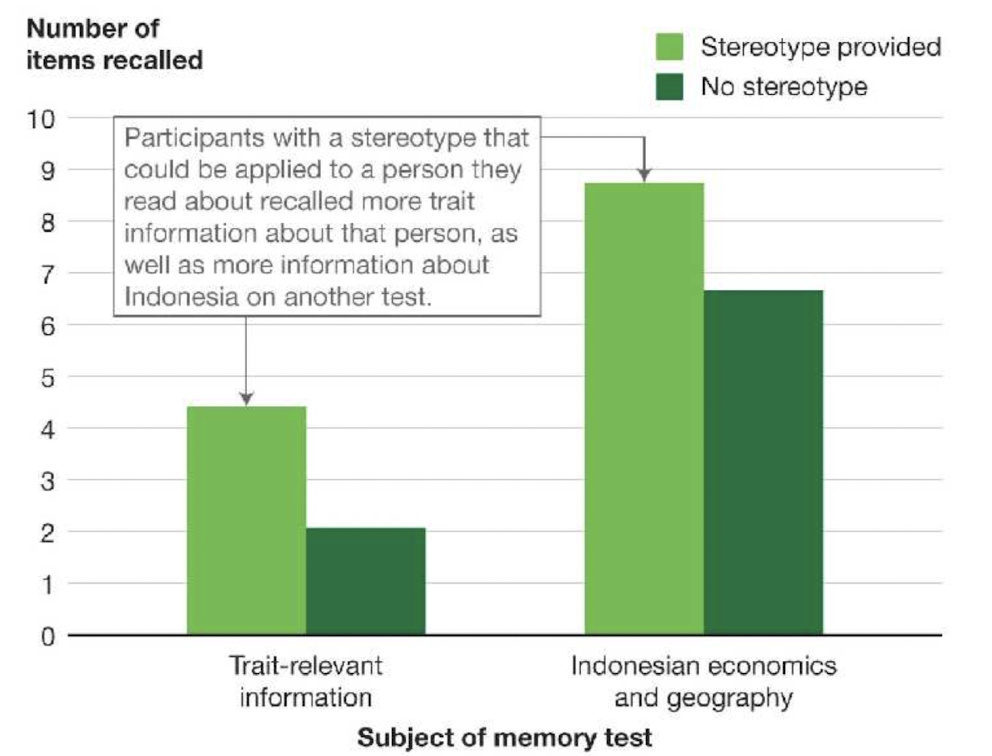
illusory correlations
see correlations between events, characteristics, categories that are not actually related - come out when processing distinctive events
attend more closely to distinctive events, so remember them better and are overrepresented in our memory (negative behaviour from minority groups is more distinctive and memorable)
paired distinctiveness
paired distinctiveness
pairing of 2 distinctive events that stand out because they occur together
self-fulfilling prophecy
people act toward members of certain groups in ways that encourage very behaviour they expect to see from groups
ex. a teacher who believes a certain group is less smart gives them less attention in class
subtyping
Explaining away exceptions to a given stereotype by creating a subcategory of the stereotyped group that can be expected to differ from group as a whole - critically analyzing contradictory evidence to our beliefs through attribution to external causes
describe own group members negative actions on more concrete level
describe out group members negative actions on more abstract level
outgroup homogeneity effect
tendency for people to assume that within-group similarity is much stronger for outgroups than for ingroups
we have more contact with members of our ingroup so we encounter variation within ingroup more often
own-race identification bias
tendency for people to be better able to recognize and distinguish faces from their own race than from other races. - interact with ingroup more
automatic and controlled stereotype processing
our reactions to different groups of people guided by this - can override but not eliminate
can be triggered even if we do not want them to be
individual approaches to prejudice reduction
media/school programs to promote acceptance of outgroups
perspective taking (cognitive)
loving-kindness mediation (behavioural)
intergroup approaches to prejudice reduction
not contact hypothesis (disproved)
groups need to have equal status
groups must have a shared goal requiring cooperation (subordinate)
community support of intergroup contact
encouragement of one-on-one interactions between group members
causes outgroup members to be seen as individuals (personalization), positive feelings generalized to whole group, think of themselves sharing a common identity
multiculturalism
culture and ethnicity are central to people’s identities
increases perspective taking, encourages positive evaluations of group members
White people can view it as an identity threat
colour-blindness
culture and ethnicity as skin deep
can lead to more prejudice/discrimination
primed stereotypes
procedure used to increase accessibility of a concept or schema
implicit vs. explicit attitudes
uncorrelated
implicit matter for discrimination especially when cognitive resources are taxed, fatigue, time pressure, when motivation appears unbiased
explicit matter for discrimination when conscious reflection is possible/desirable
changing impllict involve re-learning new associations
can playing together reduce prejudice? (Mousa, 2020)
Randomized Christian Iraqi refugees to play soccer with other Christian Iraqis or Muslims - playing with Muslims improved attitudes/behaviours Christians had towards Muslims
effects did not generalize non-soccer contexts
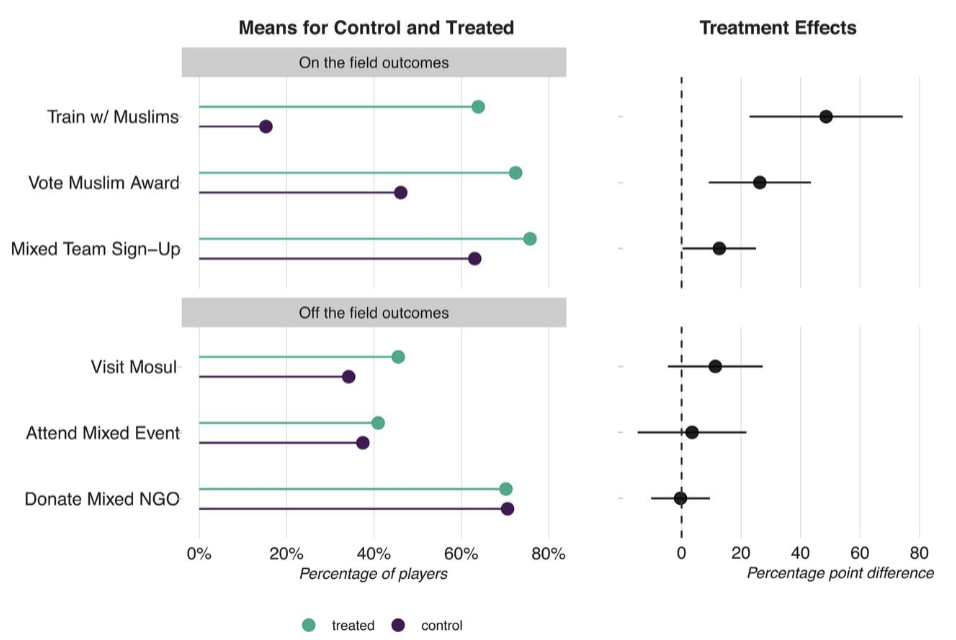
strategies to reduce prejudice/conflict
superordinate goals and identity
unlearning implicit associations
perceived similarity between groups
multiculturalism as a cultural value
positive, equal status contact with one-on-one interactions with people of other groups
perspective taking
social identity theory
self-esteem comes not only from personal identity and accomplishments but also from status and accomplishments of various groups we belong it
rate things higher when they are associated with our identity
want to boost our social groups because of this
basking in reflected glory
social groups are part of every individual’s identity, so people are motivated to denigrate outgroup members when their groups are under threat
basking in reflected glory
taking pride in the accomplishments of other people in one’s groups (when sports fan identifies with a winning team)
group
collection of individuals that have relations to one another that make them interdependent to some degree
nature of group living
groups vary in degree of group entitativity and hierarchy
group entitativity
mutual interdependence and cohesion
low = people waiting at a bus stop
moderate = co-workers in a unit
high = army unit fighting and dying together
group hierarchy
arrangement of individuals in group in terms of relative power
low = book club
moderate = sports team
high = political party
evolutionary benefits of group living
protection from predation and human violence
collective hunting of big game
cultural learning (our collective brain needs groups)
social exclusion is painful (Eisenberger, Lieberman, Williams, 2003)
greater activation of dorsal anterior cingulate cortex (dACC) when excluded
does dependent (feeling more upset = greater activation of dACC)
tylenol and advil may be able to heal a broken heart
social facilitation
effect of presence of others on performance
Zajonc’s theory: does presence of others increase or decrease performance?
Zajonc’s social facilitation
mere presence of others enhances dominant (well-practiced) response, inhibits less dominant (not well-practiced response)
arousal level - more inclined to do what we’ve already automatically inclined to do
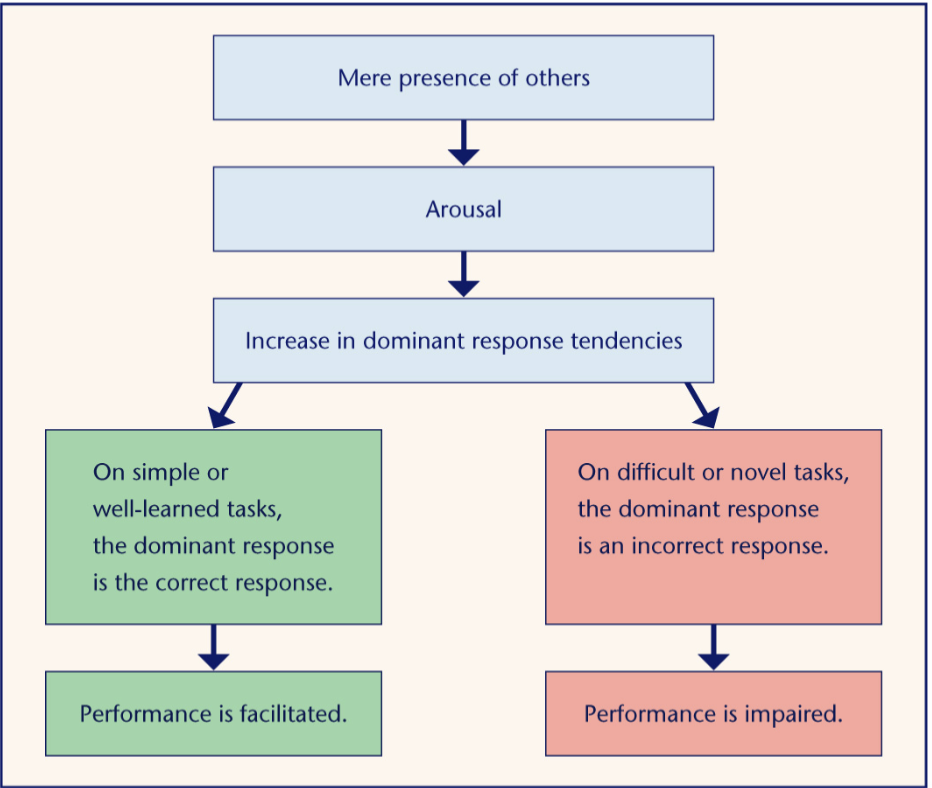
evaluation apprehension
concern about looking bad in the eyes of others, about being evaluated
instead of mere presence, newer research has found that this has a stronger effect on social facilitation
social loafing
decreased effort put forth by individuals when working in a group - counter to social facilitation
Ingham 1974: blindfolded participants pulled harder in tug of war when they thought they were alone
burglars working in groups more likely to get caught
Why? diffusion of responsibility
less social loafing when
task is challenging and involving
individuals are identifiable
members are friends
groups are cohesive
in collectivistic cultures and among women
wisdom of the crowd
prediction markets more accurate than expert opinion, average judgement converges on the correct solution
crowd has a diversity of opinions
individual opinions are independent of one another
crowd should be able to aggregate individual opinions into one collective decision
why wisdom of the crowd? (Harvey, 2013; Phillips and Lloyd, 2006)
hard mentalities are detrimental to wise decisions and creativity
aggregated info yields better and more creative solution - diverse views weaken confirmation bias and combine best features of ideas
as long as individuals’ judgements are independent of one another - homogenous groups are not wise
Groupthink
social pressures to reach consensus in highly cohesive group which leads to suboptimal decisions
disastrous decisions (Kennedy’s Bay of Pigs invasion, 2nd Iraq war)
why smart individuals can end up making bad decisions as a group
conditions that foster groupthink
stressful situation
like minded members of group (homogeneity)
isolation from outside info and influences
lack of clear procedures
strong, authoritarian group leader
symptoms of groupthink
illusion of invulnerability (can’t do any wrong)
dissent is discouraged
self-censorship, illusion of unanimity
one-sided debate (collective rationalization)
unwillingness to consider alternatives
self-censorship
strategies to reduce groupthink
encourage criticism and diverse viewpoints
input from outside sources
generate different ideas, approaches before decisions are made
watch out for illusion of invulnerability
group polarization
group decisions tend to be more extreme than those made by individuals - contributor to social division
caused by persuasiveness of information brought up by group and the desire to risk take when in groups
the paradox of diversity (Muthukrishna, 2023)
diversity improves creativity, innovation, problem-solving, but diverse groups are more conflict prone than homogenous groups
benefits of diverse groups
more creativity, better decisions (broader reservoir of info, powerful antidote against confirmation bias)
cultural role models take down stereotypes, facilitate positive social change
rectify past imbalances and injustices
powerful antidote against prejudice (positive contact)
challenges of diverse groups
social interactions are less smooth
lower levels of trust, more concerns about disrespect
greater perceived interpersonal conflict
less social cohesions
more diverse countries are not prone to internal conflict unless social fractionization is territorial
good ways to handle the diversity paradox
establishing common culture
increasing communication
creating shared experiences, rituals, social identity
self-awareness, emotional literacy
cultural experts
subordinate goals
teach about discrimination
power
ability to control one’s own outcomes and those of others - person’s capacity to influence
relational nature manifests in social hierarchy
social hierarchy
arrangement of individuals in terms of their rank or power relative to power of other group members - form quickly as they help solve problems of group living
gaining power
path of virtue: individuals do things good for their group and group members recognize these contributions
path of vice: individuals dominant others through force, fraud, manipulation, weakening of people around us
approach/inhibition theory of power
when people experience elevated power, they should show approach behaviour - less concerned about evaluations and more inclined to act on goals
when people are less powerful, they are more vigilant and careful in making judgements, more restrained in taking action
power’s influence on social cognition
become overconfident - overestimate accuracy of knowledge and success of their actions, are somewhat out of touch
power and behaviour
when feeling powerful, we feel freer to act on goals and desires - disinhibits
deindividuation
experience a loss of individual identity when in a group
anonymity and diffusion of responsibility
diminished self-observation and self-evaluation
creates impulsive, irrational, destructive behaviour characteristic of mobs
individuation
attention of the self - act carefully in accordance with sense of propriety
self-awareness theory
decreases only in the presence of large crowds
self-awareness theory
when people focus their attention on themselves, they become more concerned with self-evaluation and how their behaviour conforms
spotlight effect
people’s conviction that other people are paying attention to appearance and behaviour than is actually the case
is boxing aggression?
You are consenting to be hit but you are also hitting someone else, still with an underlying theme of aggression
BDSM → full consent to inflict pain - people want this and don’t register it as harm being inflicted
Corporal punishment: aggression, but we excuse this
Is there a cultural script that says this is ok?
Has to do with consent - basically yes and no
spread of violence in society
violent deaths from warfare are lower in state societies with centralized authority
large variability among non-state societies
the past was not peaceful and there still are wars and genocides - but wars and fatalities from wars are on steep decline
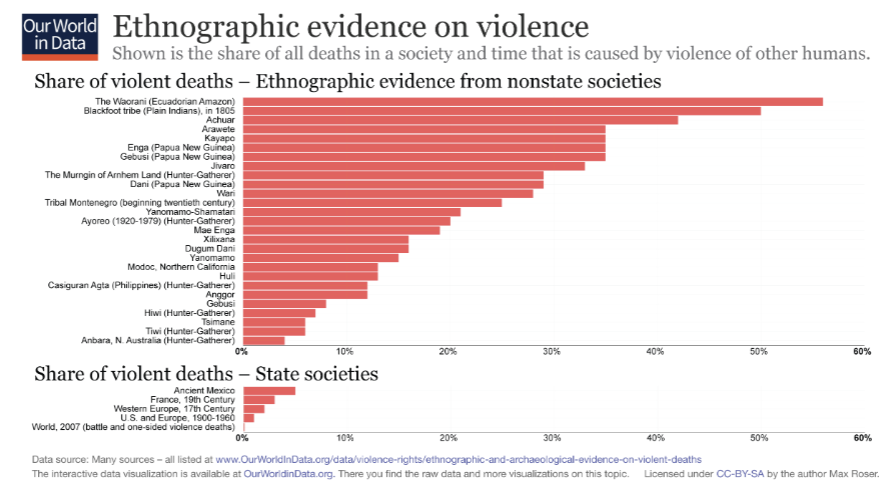
general aggression model
broad approach to understanding causes of aggression through a focus on situational factors, construal factors, biological and cultural contributions
hostile aggression
behaviour intended to harm another either physically or psychologically - motivated by feelings of anger and hostility
instrumental aggression
behaviour intended to harm another in service of motives other than pure hostility (attracting attention, acquiring wealth, advancing political or ideological causes)
consensual aggression
aggression that is mutually consensual, follows a particular cultural script - sports, acting, sexual activity, etc.
hot weather and aggression
related to higher rates
2.6% more violent crimes occur in summer than the cooler months in the US
more acts of violence occur in cities with higher temperatures
baseball pitchers more likely to hit batters with the ball as weather gets hotter
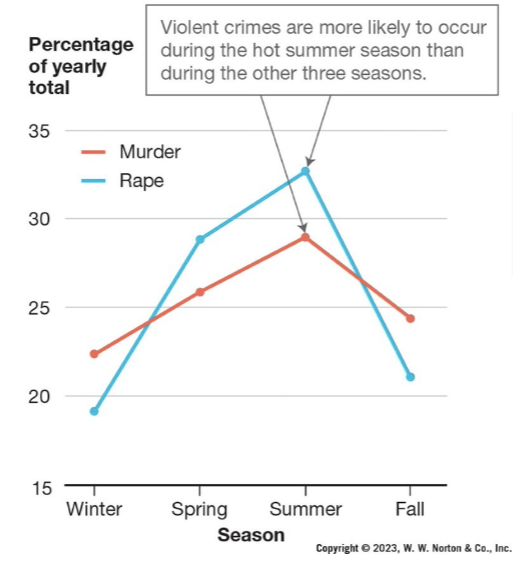
violent video games and aggression
appears to increase aggressive behaviour, reduce prosocial behaviour (helping, altruism), increase aggressive thoughts and emotions, increase blood pressure and heart rate
effects observed in children and adults US, Europe, and Japan
social rejection and aggression
when participants experienced rejection, fMRI images saw that the anterior cingulate, which processes physical pain, lit up
people who report chronic sense of rejection are more likely to act aggressively in their romantic relationships
does economic inequality increase violence?
income inequality appears to predict higher homicide rates
powerful feelings of social rejection may trigger violence
inequality undermines feelings of trust and goodwill among people
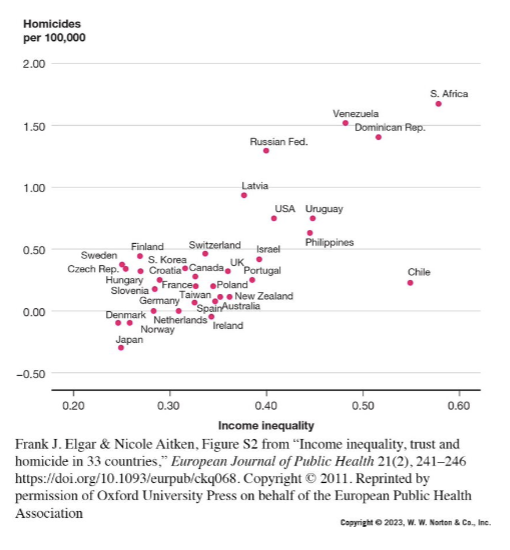
construal and anger
how people interpret situation plays a vital role in whether they will act aggressively
participants more likely to deliver more aggression when a weapon was present in the room (presence/possession of a weapon makes people act more aggressively)
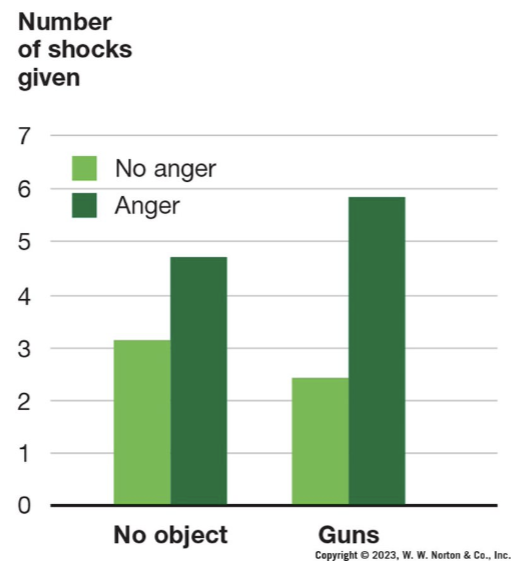
dehumanization
attribution of nonhuman characteristics to groups other than one’s own - unleash aggression because its easier to harm others who seem less like ourselves
intensifies as loyalty to valued social groups increases
distancing from the causes of aggression
people can modify their feelings of anger or tendencies toward aggression by looking at frustrating issues from a distance
dignity cultures
inherent self-worth
authenticity is a virtue
individualistic cultures
less hierarchical, strong rule of law
face cultures
socially conferred self-worth determined by performing social obligations
modesty and harmony are a virtue
confucian cultures
stable social hierarchies, strong rule of law
honour cultures
socially conferred self-worth, determined by social image of toughness
defence of one’s reputation (including insult related violence) - high sensitivity
mediterranean cultures, US South
unstable social hierarchies, weak rule of law
willing to use violence to avenge wrongs, more aggressive
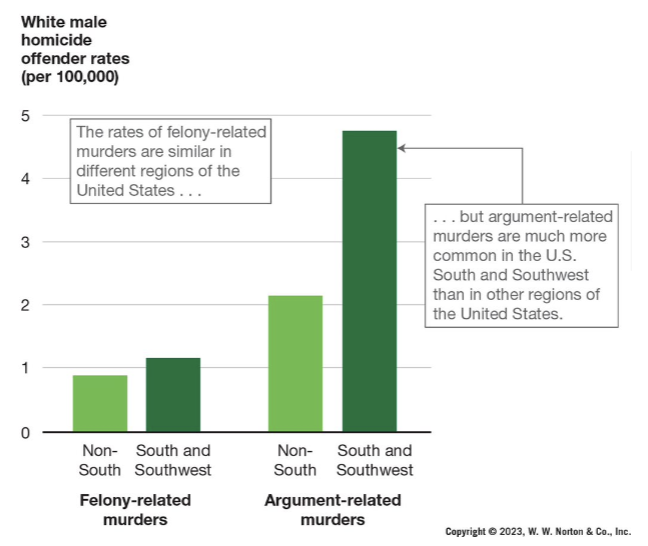
culture and sexual violence
rape-prone cultures that emphasize male toughness and cultures that relegate women to lower status in society
rape-prone cultures
men used rape as an act of war against enemy women as a ritual act or a threat to remain submissive
evolution and aggression
Inclusive fitness
violence in stepfamilies
inclusive fitness
reproductive success and passing on of genes
violence in stepfamilies
natural selection rewards parents who devote resources to own offspring - more violence against stepfamily
gender and aggression
men more likely to be involved in violent/criminal behaviour - socialized, precarious manhood hypothesis
long history of violence against women by men
men more likely to be victims of violence
combo of hormone levels, cultural learning and socialization
women tend to display more relational/emotion aggression